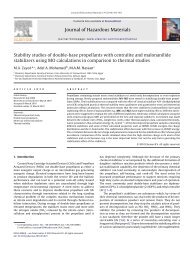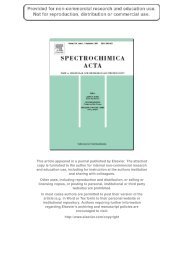Spectrophotometric determination of carbamazepine ... - MA Zayed
Spectrophotometric determination of carbamazepine ... - MA Zayed
Spectrophotometric determination of carbamazepine ... - MA Zayed
You also want an ePaper? Increase the reach of your titles
YUMPU automatically turns print PDFs into web optimized ePapers that Google loves.
<strong>carbamazepine</strong>. The data obtained are shown in Figure (3). The results indicate that a 1:1 [Mo(V)-<br />
thiocyanate]: [drug] ion–pair is formed through the electrostatic attraction between positive protonated<br />
drug CBZ + and thiocyanate negative complex as shown in scheme (3).<br />
N<br />
(Mo (SCN) 6<br />
) -<br />
O NH 3<br />
Carbamazepine -Mo (V)<br />
Scheme (3). Proposed structure <strong>of</strong> Mo(V)-carbmazepine ion pair.<br />
Validity <strong>of</strong> Beer's law:<br />
Under the optimum conditions described above, the calibration graph can be constructed for<br />
the investigated drug. Table (1) shows the analytical parameters obtained for the <strong>determination</strong> <strong>of</strong><br />
<strong>carbamazepine</strong> using Mo(V)-thiocyanate reagent. The absorbance-concentration curve is found to be<br />
rectilinear and Beer's law is obeyed in the concentration range 10-350 µg ml -1 . The mean recovery<br />
values obtained amount in the range 100-100.3%. The correlation coefficient <strong>of</strong> the data obtained is<br />
0.9998. The Sandell sensitivity (S) is found to be 2.22 µg cm -2 . The limit <strong>of</strong> detection (LOD) and<br />
quantification (LOQ) are found to be 3.36 and 11.21 µg mL -1 , respectively. The SD is found to be<br />
0.04–0.09 and the RSD are 0.63–2.17%. The low values <strong>of</strong> the relative standard deviation indicate the<br />
high accuracy and precision <strong>of</strong> the method. This is supported also by the calculated values <strong>of</strong> Sandell<br />
sensitivity which indicates the high sensitivity <strong>of</strong> the method.<br />
3.2. Determination <strong>of</strong> mosapride citrate (MOC) using BTB and BCG reagents<br />
Mosapride citrate drug is present in positively charged protonated form and dyestuff reagents<br />
present mainly in anionic form at pH ≥ 3. So by adding 0.7 and 1 mL <strong>of</strong> pH 4.0 and 3.0 <strong>of</strong> universal<br />
buffer using BTB and BCG reagents, respectively, the ion-pairs which are extracted with 10 mL <strong>of</strong><br />
chlor<strong>of</strong>orm (5 mL x 2) and 10 mL <strong>of</strong> methylene chloride (10 mL x 1) using BTB and BCG,<br />
respectively, are formed. The spectra <strong>of</strong> the ion-pair reaction products show characteristic λ max at 412<br />
and 416 nm for mosapride citrate using BTB and BCG reagents, respectively (Figure (4)). The<br />
optimum reaction conditions for <strong>determination</strong> <strong>of</strong> the ion-pair complexes were established. The effect<br />
<strong>of</strong> varying the concentration <strong>of</strong> 1 mg mL -1 BTB or 0.02% w/v BCG on the intensity <strong>of</strong> the coloured<br />
8






